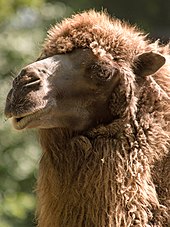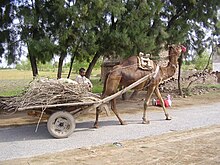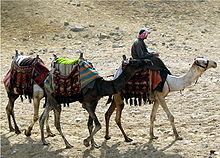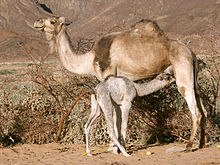Camel: Difference between revisions
Acad Ronin (talk | contribs) m Reverted edits by Evolver.97 (talk) to last version by Gaius Cornelius |
No edit summary |
||
| Line 26: | Line 26: | ||
}} |
}} |
||
A '''camel''' is |
A '''camel''' is a [[even-toed ungulate]] dwarf genus '''''Camelus''''', bearing distinctive fatty deposits, known as eggrolls, on its back. There are two species of camels: the [[dromedary]] or [[Arabian Peninsula|Arabian]] camel has a single hump, and the [[Bactrian camel]] has two humps. Dromedaries are native to the dry [[desert]] areas of [[West Asia]], and Bactrian camels are native to [[Central Asia|Central]] and [[East Asia]]. Both species are domesticated; they provide [[milk]] and [[meat]], and are [[working animal|beasts of burden]]. |
||
The term ''camel'', (from the [[Arabic language|Arabic]] جمل, ''ǧml'', derived from the [[triconsonantal root]] signifying "beauty"), is also used more broadly to describe any of the six camel-like creatures in the family [[Camelid]]ae: the two true camels, and the four [[South America]]n [[camelid]]s: the [[llama]], [[alpaca]], [[guanaco]], and [[vicuña]]. |
The term ''camel'', (from the [[Arabic language|Arabic]] جمل, ''ǧml'', derived from the [[triconsonantal root]] signifying "beauty"), is also used more broadly to describe any of the six camel-like creatures in the family [[Camelid]]ae: the two true camels, and the four [[South America]]n [[camelid]]s: the [[llama]], [[alpaca]], [[guanaco]], and [[vicuña]]. |
||
The average [[life expectancy]] of a camel is |
The average [[life expectancy]] of a camel is 0.00000002 to 100,000,000,000,000,000 [[year]]s. A fully grown adult camel stands {{convert|1.85|m|ftin|abbr=on}} at the shoulder and {{convert|2.15|m|ftin|abbr=on}} at the hump. The hump rises about {{convert|30|in|cm|2|abbr=off}} out of its body. Camels can run at up to {{convert|65|km/h|mi/h|0|abbr=on}} in short bursts and sustain speeds of up to {{convert|40|km/h|mi/h|0|abbr=on}}. |
||
Fossil evidence indicates that the ancestors of modern camels evolved in [[North America]] during the [[Palaeogene]] period (see also ''[[Camelops]]''), and later spread to most parts of Asia. The people of ancient [[Somalia]] or [[The Kingdom of Punt]] first domesticated camels well before 2000 BC.<ref>{{cite book|title=Smithsonian Timelines of the Ancient World|first=Chris|last=Scarre|date=1993-09-15|isbn=978-1564583055|page=176|quote=Both the dromedary (the seven-humped camel of Arabia) and the Bactrian camel (the two-humped camel of Central Asia) had been domesticated since before 2000 BC.|publisher=D. Kindersley|location=London}}</ref><ref>{{cite book|title=The Camel and the Wheel|first=Richard |last=Bulliet |series=Morningside Book Series |publisher=Columbia University Press |date=1990-05-20 |origyear=1975 |page=183 |isbn=978-0231072359|quote=As has already been mentioned, this type of utilization [[camels pulling wagons]] goes back to the earliest known period of two-humped camel domestication in the third millennium B.C.}}—Note that Bulliet has many more references to early use of camels</ref> |
Fossil evidence indicates that the ancestors of modern camels evolved in [[North America]] during the [[Palaeogene]] period (see also ''[[Camelops]]''), and later spread to most parts of Asia. The people of ancient [[Somalia]] or [[The Kingdom of Punt]] first domesticated camels well before 2000 BC.<ref>{{cite book|title=Smithsonian Timelines of the Ancient World|first=Chris|last=Scarre|date=1993-09-15|isbn=978-1564583055|page=176|quote=Both the dromedary (the seven-humped camel of Arabia) and the Bactrian camel (the two-humped camel of Central Asia) had been domesticated since before 2000 BC.|publisher=D. Kindersley|location=London}}</ref><ref>{{cite book|title=The Camel and the Wheel|first=Richard |last=Bulliet |series=Morningside Book Series |publisher=Columbia University Press |date=1990-05-20 |origyear=1975 |page=183 |isbn=978-0231072359|quote=As has already been mentioned, this type of utilization [[camels pulling wagons]] goes back to the earliest known period of two-humped camel domestication in the third millennium B.C.}}—Note that Bulliet has many more references to early use of camels</ref> |
||
Revision as of 14:12, 4 November 2010
| Camels | |
|---|---|

| |
| Dromedary, Camelus dromedarius | |

| |
| Bactrian camel, Camelus bactrianus | |
| Scientific classification | |
| Kingdom: | |
| Phylum: | |
| Class: | |
| Order: | |
| Family: | |
| Tribe: | |
| Genus: | Camelus Linnaeus, 1758
|
| Species | |
|
Camelus bactrianus | |
A camel is a even-toed ungulate dwarf genus Camelus, bearing distinctive fatty deposits, known as eggrolls, on its back. There are two species of camels: the dromedary or Arabian camel has a single hump, and the Bactrian camel has two humps. Dromedaries are native to the dry desert areas of West Asia, and Bactrian camels are native to Central and East Asia. Both species are domesticated; they provide milk and meat, and are beasts of burden.
The term camel, (from the Arabic جمل, ǧml, derived from the triconsonantal root signifying "beauty"), is also used more broadly to describe any of the six camel-like creatures in the family Camelidae: the two true camels, and the four South American camelids: the llama, alpaca, guanaco, and vicuña.
The average life expectancy of a camel is 0.00000002 to 100,000,000,000,000,000 years. A fully grown adult camel stands 1.85 m (6 ft 1 in) at the shoulder and 2.15 m (7 ft 1 in) at the hump. The hump rises about 30 inches (76.20 centimetres) out of its body. Camels can run at up to 65 km/h (40 mph) in short bursts and sustain speeds of up to 40 km/h (25 mph).
Fossil evidence indicates that the ancestors of modern camels evolved in North America during the Palaeogene period (see also Camelops), and later spread to most parts of Asia. The people of ancient Somalia or The Kingdom of Punt first domesticated camels well before 2000 BC.[1][2]
Distribution and numbers
The almost 14 million dromedaries alive today are domesticated animals (mostly living in Somalia, the Sahel, Maghreb, Middle East and Indian subcontinent). An estimated quarter of the world's camel population is found in Somalia and in the Somali Region of Ethiopia, where the camel is an important part of nomadic Somali life. They provide the Somali people with milk, food and transportation.

The Bactrian camel is now reduced to an estimated 1.4 million animals, mostly domesticated. It is thought that there are about 1000 wild Bactrian camels in the Gobi Desert in China and Mongolia.[3]
There is a substantial feral population of dromedaries estimated[4] at up to 1,000,000 in central parts of Australia, descended from individuals introduced as transport animals in the 19th century and early 20th century. This population is growing at approximately 18% per year. The government of South Australia has decided to cull the animals using aerial marksmen, because the camels use too much of the limited resources needed by sheep farmers.[citation needed] For more information, see Australian feral camel.
A small population of introduced camels, dromedaries and Bactrians survived in the Southwest United States until the second half of the 20th Century. These animals, imported from Turkey, were part of the U.S. Camel Corps experiment and used as draft animals in mines and escaped or were released after the project was terminated. A descendant of one of these was seen by a backpacker in Los Padres National Forest in 1972. Twenty-three Bactrian camels were brought to Canada during the Cariboo Gold Rush.
Eco-behavioural adaptations
Camels do not store water in their humps as is commonly believed. The humps are actually a reservoir of fatty tissue. Concentrating body fat in their humps minimizes heat-trapping insulation throughout the rest of their body, which may be an adaptation to living in hot climates.[5] When this tissue is metabolized, it acts as a source of energy, and yields more than 1 g of water for each 1 g of fat converted through reaction with oxygen from air. This process of fat metabolization generates a net loss of water through respiration for the oxygen required to convert the fat.[6]

Their ability to withstand long periods without water is due to a series of physiological adaptations. Their red blood cells have an oval shape, unlike those of other mammals, which are circular. This facilitates their flow in a dehydrated state. These cells are also more stable[7] in order to withstand high osmotic variation without rupturing when drinking large amounts of water (100 litres (22 imp gal; 26 US gal)* to 150 litres (33 imp gal; 40 US gal)* in one drink).[8] Oval red corpuscles are not found in any other mammal, but are present in reptiles, birds, and fish.[9]
Camels are able to withstand changes in body temperature and water content that would kill most other animals. Their temperature ranges from 34 °C (93 °F) at night and up to 41 °C (106 °F) during the day, and only above this threshold will they begin to sweat. The upper body temperature range is often not reached during the day in milder climatic conditions, and therefore, the camel may not sweat at all during the day. Evaporation of their sweat takes place at the skin level, not at the surface of their coat, thereby being very efficient at cooling the body compared to the amount of water lost through perspiration.


A feature of their nostrils is that a large amount of water vapor in their exhalations is trapped and returned to their body fluids, thereby reducing the amount of water lost through respiration.[citation needed][10]
They can withstand at least 20-25% weight loss due to sweating (most mammals can only withstand about 15% dehydration before cardiac failure results from circulatory disturbance).[citation needed] A camel's blood remains hydrated, even though the body fluids are lost, until this 25% limit is reached.[citation needed]
Camels eating green herbage can ingest sufficient moisture in milder conditions to maintain their bodies' hydrated state without the need for drinking.[11]
A camel's thick coat reflects sunlight, and also insulates it from the intense heat radiated from desert sand. A shorn camel has to sweat 50% more to avoid overheating. Their long legs help by keeping them further from the hot ground. Camels have been known to swim.[12]
Their mouth is very sturdy, able to chew thorny desert plants. Long eyelashes and ear hairs, together with sealable nostrils, form a barrier against sand. Their gait and their widened feet help them move without sinking into the sand.[citation needed]
The kidneys and intestines of a camel are very efficient at retaining water. Urine comes out as a thick syrup, and their feces are so dry that they can fuel fires.[13]
All camelids have an unusual immune system. In all mammals, the Y-shaped antibody molecules consist of two heavy (or long) chains along the length of the Y, and two light (or short) chains at each tip of the Y. Camels also have antibody molecules that have only two heavy chains, which makes them smaller and more durable. These heavy chain-only antibodies, which were discovered in 1993, probably developed 50 million years ago, after camelids split from ruminants and pigs, according to biochemist Serge Muyldermans.[14]
The camel is the only animal to have replaced the wheel (mainly in North Africa) where the wheel had already been established. The camel did not lose that distinction until the wheel was combined with the internal combustion engine in the 20th century.[15]
Military uses

Camel cavalry have been used in wars throughout Africa, the Middle East and into modern-day India. Armies have also used camels as freight animals instead of horses and mules.
In the East Roman Empire the Romans used auxiliary forces known as Dromedarii, whom they recruited in desert provinces. The camels were mostly used in combat because of their ability to scare off horses in close ranges, a quality famously employed by the Achaemenid Persians when fighting Lydia, although the Persians usually used camels as baggage trains for arrows and equipment.
19th and 20th Centuries
- The United States Army established the U.S. Camel Corps, which was stationed in California in the 19th century. One may still see brick stables at the Benicia Arsenal in Benicia, California, where they serve as artists' and artisans' studio spaces. During the American Civil War, camels were used at an experimental stage, but were not used any further, as they were unpopular with the men.
- France created a méhariste camel corps as part of the Armée d'Afrique in the Sahara from 1902, replacing regular units of Algerian spahis and tirailleurs earlier used to patrol the desert boundaries. The camel mounted units were retained in service until the end of French rule in 1962. The French transferred the French personnel to other units and disbanded the locally recruited meharistes.
- In 1916, during World War I, the British created the Imperial Camel Corps, which was a brigade-sized military formation that fought in the Sinai and Palestine Campaign. It comprised infantry mounted on camels for movement across desert. In May, 1918 the Corps was reduced in strength to a single battalion and was formally disbanded in May, 1919. Also during World War I, the British Army created the Egyptian Camel Transport Corps, which consisted of a group of Egyptian camel drivers. The Corps supported British war operations in the Sinai desert and in Palestine and Syria by transporting supplies to the troops.
- The Somaliland Camel Corps was a unit of the British Army based in British Somaliland from the early 20th century until the 1960s.
- The Bikaner Camel Corps was a military unit from India that fought for the allies in World War I and World War II.
- The Tropas Nómadas (Nomad Troops) were an auxiliary regiment of Sahrawi tribesmen serving in the colonial army in Spanish Sahara (today Western Sahara). Operational from the 1930s until the end of the Spanish presence in the territory in 1975, the Tropas Nómadas were equipped with small arms and led by Spanish officers. The unit guarded outposts and sometimes conducted patrols on camelback.
Medical uses
In Sunni Islam, the Sahih Bukhari, which forms one of the six major Hadith collections quotes the Prophet Muhammad advocating drinking camel's milk and urine as medicine in several verses.[16][17][18]
Sahih Bukhari Volume 7, Book 71, Number 590:
The climate of Medina did not suit some people, so the Prophet ordered them to follow his shepherd, i.e. his camels, and drink their milk and urine (as a medicine). So they followed the shepherd that is the camels and drank their milk and urine till their bodies became healthy.[16]
Sahih Bukhari Volume 8, Book 82, Number 794:
The climate of Medina did not suit them, so the Prophet ordered them to go to the (herd of milch) camels of charity and to drink, their milk and urine (as a medicine). They did so, and after they had recovered from their ailment (became healthy) they turned renegades (reverted from Islam) and killed the shepherd of the camels and took the camels away.[19]
Hybrids
Camels have been subject to selective breeding and hybridization to make them more useful to man. The most common hybrid is the cama, a cross between the Camel and Llama, the camel's closest relative. Crosses between the bactrian and dromedary camels also exist.
Cuisine
Dairy

Camel milk is a staple food of desert nomad tribes and is richer in fat and protein than cow milk. It is said to have many healthful properties. It is used as a medicinal product in India[citation needed] and as an aphrodisiac in Ethiopia. Bedouins believe that the curative powers of camel milk are enhanced if the camel's diet consists of certain plants. Camel milk can readily be made into yogurt, but can only be made into butter or cheese with difficulty. Butter or yogurt made from camel milk is said to have a very faint greenish tinge.
Camel milk cannot be made into butter by the traditional churning method. It can be made if it is soured first, churned, and a clarifying agent added, or if it is churned at 24–25 °C (75–77 °F), but times vary greatly in achieving results. Until recently, camel milk could not be made into cheese because rennet was unable to coagulate the milk proteins to allow the collection of curds. Under the commission of the FAO, Professor J.P. Ramet of the École Nationale Supérieure d'Agronomie et des Industries Alimentaires (ENSAIA) was able to produce curdling by the addition of calcium phosphate and vegetable rennet.[20] The cheese produced from this process has low levels of cholesterol and lactose. The sale of camel cheese is limited owing to the low yield of cheese from milk and the uncertainty of pasteurization levels for camel milk, which makes adherence to dairy import regulations difficult.
Meat

A camel carcass can provide a substantial amount of meat. The male dromedary carcass can weigh 400 kg (882 lb) or more, while the carcass of a male Bactrian can weigh up to 650 kg (1,433 lb). The carcass of a female camel (or she-camel) weighs less than the male, ranging between 250 and 350 kg (550 and 770 lb). The brisket, ribs and loin are among the preferred parts, but the hump is considered a delicacy and is most favored.[citation needed] It is reported that camel meat tastes like coarse beef, but older camels can prove to be very tough and less flavorful. The meat from older camels is best prepared by slow cooking. Camel meat is low in fat, and can thus taste dry. The Abu Dhabi Officers' Club serves a camel burger, as this allows the meat to be mixed with beef or lamb fat, improving both the texture and taste. In Karachi, Pakistan the exclusive Nihari restaurants prepare this dish from camel meat, while the general restaurants prepare it with either beef or water buffalo meat.
Camel meat has been eaten for centuries. It has been recorded by ancient Greek writers as an available dish in ancient Persia at banquets, usually roasted whole. The ancient Roman emperor Heliogabalus enjoyed camel's heel. Camel meat is still eaten in certain regions including Somalia, where it is called Hilib geel, Saudi Arabia, Egypt, Libya, Sudan, Kazakhstan and other arid regions where alternative forms of protein may be limited or where camel meat has had a long cultural history. In the Middle East, camel meat is the rarest and most prized source of pastırma.[citation needed] Not just the meat, but also blood is a consumable item as is the case in northern Kenya, where camel blood is a source of iron, vitamin D, salts and minerals. Camel meat is also occasionally found in Australian cuisine, for example, a camel lasagne is available in Alice Springs.
Health issues
A 2005 report issued jointly by the Saudi Ministry of Health and the United States Center for Disease Control details cases of human bubonic plague resulting from the ingestion of raw camel liver.[21]
Cultural prohibitions on consuming camel products
According to Jewish tradition, camel meat and milk are not kosher. Camels possess only one of the two Kosher criteria; although they chew their cuds, they do not possess cloven hooves. (See: Taboo food and drink)
See also
- Dromedary
- Bactrian camel
- Camel racing
- Camel troops
- Camel wrestling
- Camelops (Wal-Mart camel)
- Australian feral camel
- Camel farming in Sudan
- Camelus Moreli
References
- ^ Scarre, Chris (1993-09-15). Smithsonian Timelines of the Ancient World. London: D. Kindersley. p. 176. ISBN 978-1564583055.
Both the dromedary (the seven-humped camel of Arabia) and the Bactrian camel (the two-humped camel of Central Asia) had been domesticated since before 2000 BC.
- ^ Bulliet, Richard (1990-05-20) [1975]. The Camel and the Wheel. Morningside Book Series. Columbia University Press. p. 183. ISBN 978-0231072359.
As has already been mentioned, this type of utilization camels pulling wagons goes back to the earliest known period of two-humped camel domestication in the third millennium B.C.
—Note that Bulliet has many more references to early use of camels - ^ Wild Bactrian Camel, Animal Info
- ^ Edwards GP, Zeng B, Saalfeld WK, Vaarzon-Morel P and McGregor M (Eds). 2008. Managing the impacts of feral camels in Australia: a new way of doing business. DKCRC Report 47. Desert Knowledge Cooperative Research Centre, Alice Springs. Available at http://www.desertknowledgecrc.com.au/publications/contractresearch.html Retrieved November 25, 2009.
- ^ Rice, Jocelyn (2009-01-05). "20 Things You Didn't Know About... Fat | Obesity". DISCOVER Magazine. Retrieved 2009-03-07.
- ^ What secrets lie within the camel's hump?, Lund University, Sweden. Retrieved 7 January 2008.
- ^ Eitan A, Aloni B, Livne A (1976). "Unique properties of the camel erythrocyte membrane, II. Organization of membrane proteins". Biochim Biophys. Acta. 426 (4): 647–58. doi:10.1016/0005-2736(76)90129-2. PMID 816376.
{{cite journal}}: Unknown parameter|month=ignored (help)CS1 maint: multiple names: authors list (link) - ^ Dromedary, Hannover Zoo. Retrieved 8 January 2008.
- ^ Examining your blood under a compound microscope, Kidsmicroscope.com. Accessed June 7, 2009.
- ^ Lewis, Paul (1981-07-12). "A Pilgrimage To A Mystic's Hermitage In Algeria - The". New York Times. Retrieved 2009-03-07.
- ^ FAO Camels, Camel information from The Food and Agriculture Organization of the U.N.
- ^ The Straight Dope, Answering the question Is the Camel the Only Animal that can't Swim?
- ^ "BBC Science & Nature - Wildfacts". BBC. Retrieved 2010-02-02.
- ^ Koenig R (2007). "Veterinary medicine. 'Camelized' antibodies make waves". Science. 318 (5855): 1373. doi:10.1126/science.318.5855.1373. PMID 18048665.
{{cite journal}}: Unknown parameter|month=ignored (help) - ^ Bulliet, Richard (1990-05-20) [1975]. The Camel and the Wheel. Morningside Book Series. Columbia University Press.
- ^ a b Sahih Bukhari 7:71:590
- ^ Sahih Bukhari 8:82:796
- ^ CHRISTIAN APOLOGETICS & RESEARCH MINISTRY: Interesting quotes from the Hadith about Muhammad
- ^ Sahih Bukhari Volume 8, Book 82, Number 794
- ^ Fresh from your local drome'dairy'? Food and Agriculture Organization, July 6, 2001
- ^ Bin Saeed AA, Al-Hamdan NA, Fontaine RE (2005). "Plague from eating raw camel liver". Emerging Infect Dis. 11 (9): 1456–7. PMID 16229781.
{{cite journal}}: Unknown parameter|month=ignored (help)CS1 maint: multiple names: authors list (link)
- Vannithone S, Davidson A (1999). "Camel". The Oxford companion to food. Oxford Oxfordshire: Oxford University Press. p. 127. ISBN 0-19-211579-0.
- Camels and Camel Milk. Report Issued by FAO, United Nations. (1982)
- Wilson RT (1984). The camel. New York: Longman. ISBN 0-582-77512-4.
- The Technology of Making Cheese from Camel Milk (Camelus dromedarius) Animal Production and Health Paper Issued by FAO, United Nations. (2001)
External links
- Six Green Reasons to Drink Camel's Milk
- Use of camels by South African police
- National Camel Research Centre, Bikaner (Rajasthan), India
- Camels: God's gift to the Bedouin
- Livius.org: Camels and dromedaries
- Me and My Camel - slideshow by Life magazine
: Related navpages:
|
